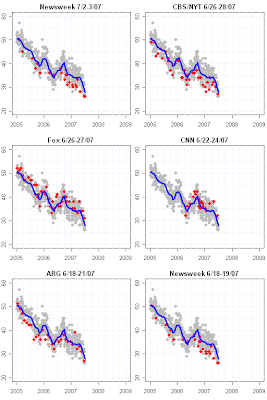
As everyone knows, the presidential contests started early this round. But how much attention are the races getting from ordinary people (i.e. not us junkies here.) The debates have had small audiences, but news coverage is quite substantial. How much attention are voters paying?
The Pew Center has asked a consistent question on attention to the campaign going back to 1988. Their question:
As I read a list of some stories covered by news organizations this past week, tell me if you happened to follow each news story very closely, fairly closely, not too closely, or not at all closely. News about candidates for the 2008 presidential election?Looking at those saying they are following the news about the campaign "very closely" we find the pattern in the figure above. Around 20% of the sample of adults say they are paying this much attention to news about the election. On the one hand, that means many are not. On the other, no previous election for which we have polling this early comes close to that 20% figure. The three previous races with any polling as early as this found 10-15% paying "very" close attention to the campaign. Only about 10 months before election day, or about the start of the primaries and caucuses, do we typically see interest move up to high levels, varying from about 18-35% over the various election years.
So this year's level of interest looks quite high, compared to previous years about this time, but at an absolute level, it remains only a fifth of adults who are glued to campaign news.
If we add "very closely" with "fairly closely", the current interest is 53%, a substantial increase, but the pattern in the plot is unchanged-- 2007 stands above any previous year, but the final attention by the general election rises to over 90% when using this combined measure, so 53% now is certain to rise to near 100% by November 2008. So either analysis says current attention is well above the norm, but still has a lot of room for increase.
The most interesting races have, oddly enough, involved incumbents named Bush. The 1992 three way race and the 2004 contest provoked the greatest attention from the Pew samples. Curiously the closest of all contests, 2000, had the second lowest final attention measure of the five completed races in the plot.
Comparing attention today with past races, we appear about 5-6 months ahead of attention in previous cycles. The 20-25% paying high attention now is usually reached around January of the election year. One interesting question is how much, and how soon, attention will grow. Perhaps we are starting high this cycle, but will converge to the range of previous cycles by January. Or perhaps we'll remain above past races through November 2008. Wait and see.
The one constituency that is certainly paying more attention earlier is pollsters. At this point in the 2004 cycle, there had been 53 national nomination polls. As of July 22 this year, we had 109, more than double the previous pace.
In part this is because we started earlier this year:

The earliest consistent polling on the 2004 race began after November 2002. (I may have missed a handful of earlier polling, but certainly not a great many.) In contrast, regular polling on 2008 began immediately after November 2004. The density of polls in 2005 and especially 2006 was substantially above comparable levels in 2002-03.
However, once the contest ramped up, the rate of new polls has been quite similar between the two years. When the blue line for 2008 turns sharply up, it runs in parallel to the 2004 polling. Clearly 2008 will ultimately far outstrip 2004, but for now we are seeing comparable rates of polling, just shifted back in time.
The shift is the equivalent of six months in the campaign schedule. If I shift the 2004 data back by exactly 6 months, the result is a near perfect match, seen below (again, after the longer run up in 2004-2006).

So for those of us obsessed with campaigns and public opinion, this is great news-- the most studied race in history in going on right now, and we have box seats.














































